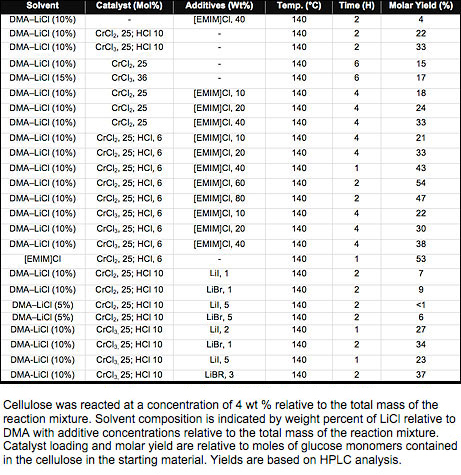Clean Technology

Efficient, Lower Cost Chemical Transformation of Lignocellulosic Biomass into Fuels and Chemicals
WARF: P08210US
Inventors: Ronald Raines, Joseph Binder
The Wisconsin Alumni Research Foundation (WARF) is seeking commercial partners interested in developing a two-step, low-temperature, nonezymatic process for converting lignocellulosic biomass and other carbohydrates into useful fuels and chemicals, such as HMF or DMF.
Overview
Cellulosic biomass has tremendous potential as a renewable resource for the production of fuels and chemicals. It is especially promising because it is inexpensive and readily available from crop residues and forests. However, it is difficult to transform into usable small molecules, such as 5-hydroxymethyl-2-furfural (HMF).
HMF is acknowledged widely as a key building block for renewable materials and has been highlight by the U.S. Dept. of Energy as a crucial renewable chemical. HMF is a versatile substitute for a range of petroleum-derived chemicals, and its derivatives have shown potential as components in polymers such as polyesters, polyamides and polyurethane foams.
Efficient production of HMF from inexpensive carbohydrate feedstocks is the major limitation in its use as a renewable chemical. Current synthesis methods require expensive fructose feedstock rather than less expensive glucose, sucrose or other carbohydrates. HMF can be produced from cellulosic biomass, but typical methods rely on high temperatures and pressures and result in yields of at most 30 percent, or use expensive ionic liquid solvents.
HMF is acknowledged widely as a key building block for renewable materials and has been highlight by the U.S. Dept. of Energy as a crucial renewable chemical. HMF is a versatile substitute for a range of petroleum-derived chemicals, and its derivatives have shown potential as components in polymers such as polyesters, polyamides and polyurethane foams.
Efficient production of HMF from inexpensive carbohydrate feedstocks is the major limitation in its use as a renewable chemical. Current synthesis methods require expensive fructose feedstock rather than less expensive glucose, sucrose or other carbohydrates. HMF can be produced from cellulosic biomass, but typical methods rely on high temperatures and pressures and result in yields of at most 30 percent, or use expensive ionic liquid solvents.
The Invention
UW-Madison researchers have developed a relatively low cost, high yielding method for converting sugars, starches and cellulosic biomass into furans, such as HMF or furfural. They found that that using N,N-dimethylacetamide-lithium chloride (DMA−LiCl) as a solvent enables the efficient synthesis of HMF or furfural in a single step from carbohydrates and even lignocellulosic biomass. The HMF then can be converted to the fuel component 2,5-dimethylfuran (DMF) via hydrogenolysis, while the furfural can be converted to furan via decarbonylation.
This simple chemical transformation could become a highly attractive process for the conversion of biomass into an array of fuels and chemicals. The method can utilize untreated lignocellulosic biomass, such as corn stover, poplar wood or switch grass. It is relatively rapid and high yielding, and takes place under moderate conditions (ambient pressure and temperature less than 200 °C). In addition, the conversion of cellulose to HMF or furfural is not hindered by the presence of other biomass components, such as lignin or protein.
This simple chemical transformation could become a highly attractive process for the conversion of biomass into an array of fuels and chemicals. The method can utilize untreated lignocellulosic biomass, such as corn stover, poplar wood or switch grass. It is relatively rapid and high yielding, and takes place under moderate conditions (ambient pressure and temperature less than 200 °C). In addition, the conversion of cellulose to HMF or furfural is not hindered by the presence of other biomass components, such as lignin or protein.
Applications
- Biofuel production
- Transforming biomass, including lignocellulosic biomass, into useful chemicals and fuels
Key Benefits
- Uses simple, inexpensive catalysts to transform cellulose into relatively high yields of a valuable product
- Conversion of lignocellulosic biomass to HMF in a single step offers straightforward access to useful HMF derivatives, such as DMF.
- Uses N,N-dimethylacetamide as a solvent, which is much less expensive than the ionic liquid solvents previously used to obtain HMF from inexpensive sugars
- Can use a single phase rather than a biphasic system
- Does not require a pretreatment process
- Takes place at ambient pressure and relatively low temperatures, unlike other chemical methods that use extreme temperatures to convert lignocellulosic biomass to fuels, thereby incurring substantial energy costs
- Biomass components that cannot be converted into HMF, such as lignin, could be reformed to produce H2 for HMF hydrogenolysis or burned to provide process heat.
Stage of Development
This process was successfully demonstrated with a number of different starting materials and with both lithium chloride and calcium chloride.
The development of this technology was supported by WARF Accelerator. WARF Accelerator selects WARF's most commercially promising technologies and provides expert assistance and funding to enable achievement of commercially significant milestones. WARF believes that these technologies are especially attractive opportunities for licensing.
The development of this technology was supported by WARF Accelerator. WARF Accelerator selects WARF's most commercially promising technologies and provides expert assistance and funding to enable achievement of commercially significant milestones. WARF believes that these technologies are especially attractive opportunities for licensing.
Additional Information
Related Intellectual Property
Publications
For current licensing status, please contact Jennifer Gottwald at [javascript protected email address] or 608-960-9854
- Binder J.B. and Raines R.T. 2009. Simple Chemical Transformation of Lignocellulosic Biomass into Furanics for Fuels and Chemicals. J. Am. Chem. Soc. 131, 1979-1985.
Figures
